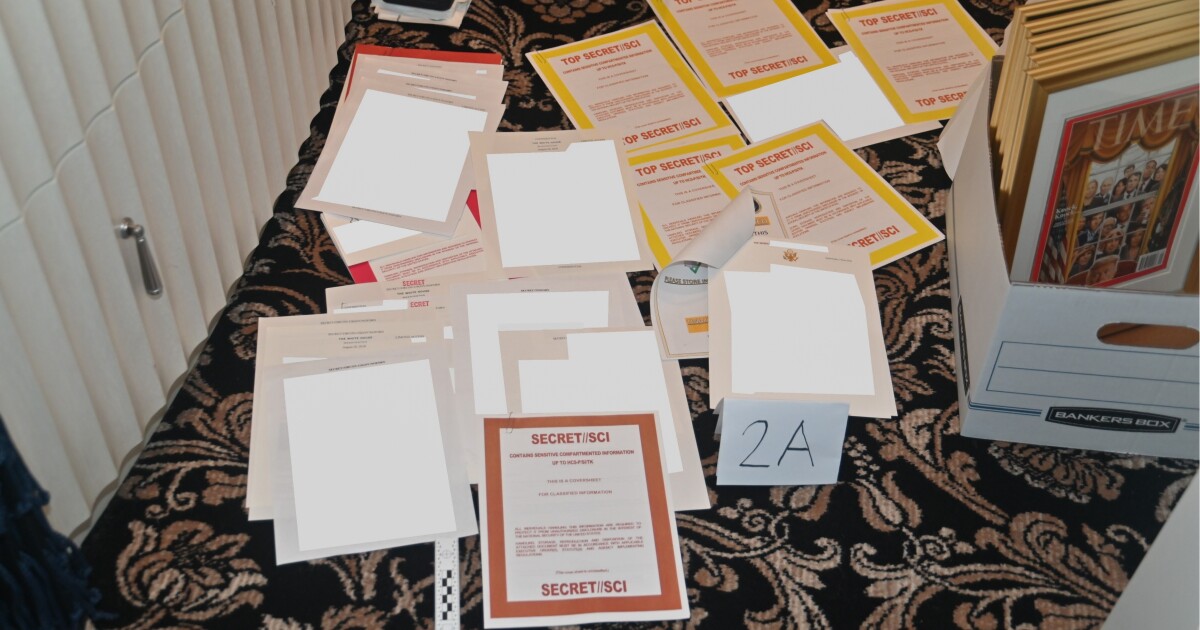Twenty-seven documents with classified and top secret markings were recovered from former President Trump’s office at his Mar-a-Lago estate in Florida, according to a detailed inventory of what the FBI removed during its court-approved search of the home last month.
The eight-page inventory detailing over 10,000 government documents removed in the search includes the location where each item was found and if it was classified, but not the subject matter. In many cases, highly classified materials are listed as having been stored in the same boxes as hundreds of unclassified items, including newspaper and magazine clippings and clothing.
Among the boxes were 48 empty folders marked with a classified banner. Those empty folders could be of particular concern as the Office of the Director of National Intelligence assesses the risks to national security that could result from disclosure of the seized materials because it could be difficult to determine what information might have been inside and where it is now.
Trump’s lawyers demanded more information about what was seized from the Palm Beach estate as part of their request for a judge to appoint a third-party special master to review the items, but objected to making the inventory public during a court hearing Thursday. The Justice Department did not object.
U.S. District Judge Aileen Cannon of the Southern District of Florida ordered the unsealing of a status report on the Justice Department’s investigation as well as the detailed property inventory Friday morning.
Cannon is still weighing whether to appoint a special master to determine whether the materials are covered by attorney-client privilege. Trump’s team also wants the special master to decide whether the former president can claim executive privilege over the documents.
The Justice Department has objected to the appointment, saying review by a special master would delay its investigation and hinder a national security review by the intelligence community. It also contends that the documents belong to the government, and that as a former president, Trump cannot claim executive privilege.
During their search on Aug. 8, FBI agents removed more than 100 documents containing classified information — including some marked top secret and meant to be available only in special government facilities — from the Trump estate, along with more than 30 boxes of materials containing thousands of government records.
FBI investigators are probing potential crimes, including violations of the Espionage Act and obstruction of justice.
The list gives the fullest picture yet of the scale of what was recovered. The search warrant instructed agents to take all items found stored with materials with classified markings, and in many cases they found materials with the nation’s highest security restrictions mixed in with unclassified materials.
For example, one box in Trump’s office contained 99 news clippings dated between January 2017 and October 2018 along with seven U.S. government documents marked top secret, the highest level of classification; 15 government documents marked secret, the second highest; two government documents with confidential markings, the lowest; 43 empty folders with classified banners and 28 empty folders labeled “return to staff secretary/military aide.”
In the 26 boxes removed from a storage room were 26 documents marked confidential, 11 marked top secret and 34 marked secret commingled with 9,274 government documents or photos without classification markings; five empty folders with classified banners; and 14 folders labeled “return to staff secretary/military aide.” Also in the boxes were hundreds of news articles, clothing, gifts and books.
According to the investigation status report, the FBI completed its initial review of the recovered documents on Wednesday. Materials flagged as potentially being subject to attorney-client privilege were not reviewed. Items marked classified have been segregated from the other recovered materials and are being stored separately.



















.png)

Discussion about this post